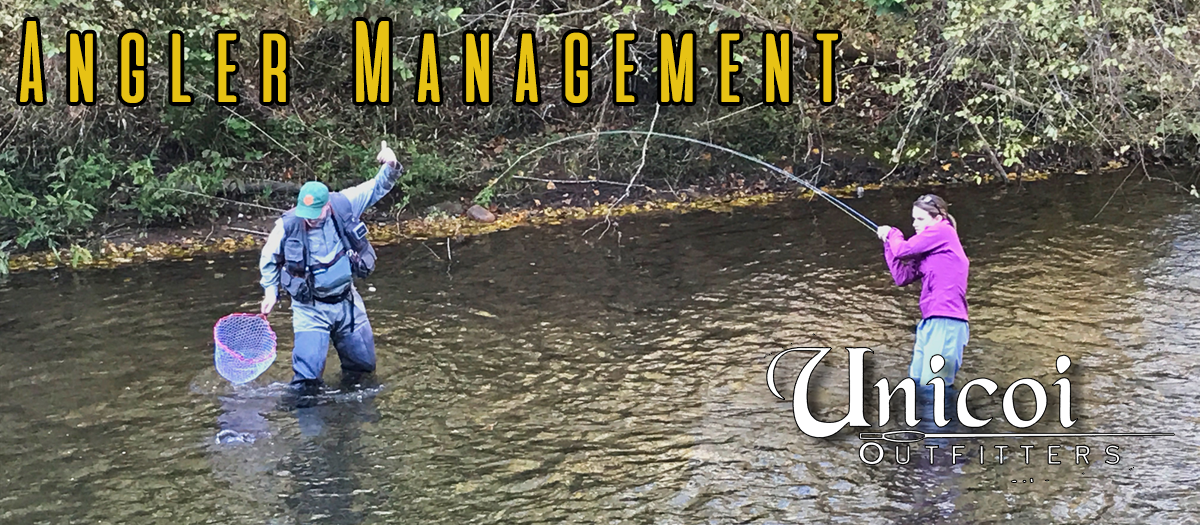
Dredging with Jeremy Hunt
Guide Tips for March
Making Sense of Split Shots and Droppers
Making Sense of Split Shots and Droppers
A common mistake that many fly fishermen make is that they do not use enough weight to get their fly near the bottom. Heavy flows on the White River, Norfork Tailwater and Lake Taneycomo are deceivingly slow, and often it will appear that a big split shot or heavy "point" fly (the fly above a dropper) is not necessary. Anglers who are learning how to fish a new piece of water should err on the side of using too much weight when starting out. If they are hitting bottom on every drift, it is time to go shallower with the indicator or lighter with respect to weight.
I have always found it helpful to really simplify my approach when it comes to determining how much weight I will use. Over the years, I have developed a system that helps keep me sane. Keep in mind that the only objective of nymph fishing is to dead-drift a fly near the bottom, and adjustments are almost always necessary in order to stay on the fish all day long. The strategies I utilize work for me, but I encourage others to get creative and try new things.
Heavy water on the White, Norfork and Lake Taneycomo
One of the most challenging fly fishing situations on the White River Basin is when flows are heavy. During periods when lake levels are above normal levels, the dams will usually release copious amounts of water. At these times, it is not only important to use enough weight to keep a fly down; anglers must also find shallow and slow areas where the fish are accessible.
When flows exceed the two unit level on Taneycomo, I will almost always use a 3/0 split-shot. A big indicator is needed to hold up the weight of this size shot. On the White, I will use a 3/0 shot once there are three or more units in operation. I can find places on Norfork to use this size of split-shot on levels that exceed a half a generator of water. As the water gets increasingly higher, the fish will tend to gravitate towards banks, structure and submerged gravel bars. A boat is necessary to fish these rivers when the water is rolling.
Moderate water on the White, Norfork and Lake Taneycomo
Drifting in a boat during moderate flows can be a blast. During these conditions, the trout on our rivers are free to move around in order to find food, and the fish are often aggressive. By moderate flows, I am referring to times when there is only one or two generators running on the White and Taneycomo. On the Norfork, moderate flows are anything less than a half a unit.
Even though the water may appear slow and shallow during moderate water releases, it is still critical to use an appropriate amount of weight. In general, I will use either a #4 shot in really shallow water, and I will use a BB or AB in deep or fast zones. Before I switch to a different size shot, I will first adjust my indicator to see if that makes a difference. The trick to catching a lot of trout on moderate flows is to find the deeper slots where the fish are concentrated.
Low water on the White, Norfork and Lake Taneycomo
I primarily use weighted flies when the water is shut down, but there are still situations where I like to fish with a non-weighted pattern below a dropper or an indicator. Non-weighted micro San Juan Worms, midge pupas and tiny emergers will produce nice fish when dead drifted through riffles and runs during low water. If I decide to use a split-shot, I will go with a #6 normally, but I've even gone as small as a #8 in the skinny water of the catch and release areas on the upper White and Norfork.
Thoughts on droppers
Now that multi-fly rigs are allowed in the catch and release areas, there are many opportunities to use droppers and point flies to fool the "refined" fish that reside in our trophy zones. If you are just learning the sport, or if you have trouble with casting at all, it is recommended that only one fly be used at a time. A single fly works very well on the White, Norfork and Lake Taneycomo. Dropper setups are prone to time-sucking tangles, but they do have a place. Two-fly rigs are perfect for really heavy water when an attractor fly above the dropper will help garner more attention, and they are also helpful in really clear water where the trout are wary of split-shots. Seldom will two-fly rigs catch significantly more fish than one-fly rigs, but it does happen, so it is important to be prepared.
Tackle and tips
There are scores of split-shot brands on the market, and almost all of them are different from each other in one way or another. I prefer the fly fishing shots that are green or black, as these colors seem to be ignored by spooky fish. It is critical to only use round split-shots - the reusable ones with 'ears' will hang up in spots where a perfectly round shot will simply roll along. Round split-shots are the only way to go, no matter where you fish.
Round split-shots are sold by Wal-Mart and other retailers - I did use the big-name brands they sell for many years. There are several issues with these products, but these problems are easy to solve. First off, many split shots are way too silver and bright. If I'm in a hurry, I will simply soak shiny shots in vinegar, which will dull their appearance significantly. I've also been known to paint split shots orange, peach or yellow. This can work really well during high water, and the messes associated with a point fly/dropper are never an issue with a painted split shot.
Another frustrating aspect of fishing with a split shot is how they like to slide around. I solve this dilemma by simply tying my lower tippet into two pieces, and I then place the split shot above the knot. This will eliminate the shot sliding down to the fly, but it is still important to make sure that any type of split-shot is firmly attached to the line so that it will not move around.
Using split-shots and droppers is just part of being a complete fly angler, even though such attachments to a leader make tangles more likely. The White, Norfork and Lake Taneycomo can be fly fished quite effectively using weighted flies during low water periods, but when the water gets high, added weight is absolutely necessary. Those who consistently get their fly down near the bottom are going to experience the most success.




No comments:
Post a Comment